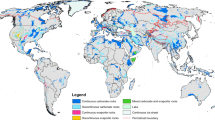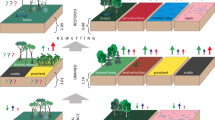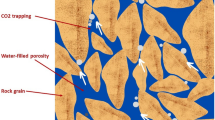Abstract
Hydrological, chemical and meteorological data collected during the years 2006–2007 at Carburangeli Cave (Italy) have provided new insights on the near-surface cycle of carbon dioxide, particularly concerning the role played by fractures and karst conduits. Carbon dioxide is trapped in the underground atmosphere essentially when its temperature is lower than the outer one. By contrast, convective air circulation disperses all the excess CO2 in the external environment when the thermal differential is inverted. The network of fractures and karst conduits then works, in the vadose zone, as a re-circulator of CO2 from the soil to the atmosphere. The total amount of CO2 fixed in the underground is controlled, during the wet season, by the amount of infiltrating waters, which act as the main carrier of CO2 in the subsoil. By contrast, during the dry season, gravitational drainage is responsible for the accumulation of carbon dioxide in the underground voids. The quantitative balance demonstrated that the degassed CO2 amounts are one order of magnitude higher than the dissolved CO2. In light of this, if the near-surface outgassing processes are not taken into account, CO2 budgets may be affected by significant errors.










Similar content being viewed by others
References
Abate B, Catalano R, Renda P (1985) Schema geologico dei Monti di Palermo (Sicilia). Boll Soc Geol Ital 97:807–819
Albert MR (2002) Effects of snow and firn ventilation on sublimation rates. Ann Glaciol 35:52–56
Baker A, Brunsdon C (2003) Non-linearities in drip water hydrology: an example from Stump Cross Caverns, Yorkshire. J Hydrol 277:151–163
Baldini JUL, McDermott F, Hoffmann DL, Richards DA, Clipson N (2008) Very high-frequency and seasonal cave atmosphere PCO2 variability: implications for stalagmite growth and oxygen isotope-based paleoclimate records. Earth Planet Sci Lett 272:118–129
Banner JL, Guilfoyle A, James EW, Stern LA, Musgrove M (2007) Seasonal variations in modern speleothem calcite growth in Central Texas, USA. J Sediment Res 77:615–622
Campbell GS, Norman JM (1998) An introduction to environmental biophysics. Springer, New York
Chiodini G, Frondini F, Cardellini C, Parello F, Peruzzi L (2000) Rate of diffuse carbon dioxide earth degassing estimated from carbon balance of regional aquifers: the case of Central Apennine (Italy). J Geophys Res 105:8423–8434
Collister C, Mattey D (2008) Controls on water volume at speleothem drip sites: an experimental study. J Hydrol 358(3–4):259–267
D’Alessandro W (2006) Gas hazard: an often neglected natural risk in volcanic areas. In: Martin-Duque JF (ed) Geo-environment and landscape evolution II. WIT Press Southampton, UK, pp 369–378
Ek C, Gewelt M (1985) Carbon dioxide in cave atmospheres. New results in Belgium and comparison with other countries. Earth Surf Process 10:173–187
Fairchild IJ, Smith CL, Baker A, Fuller L, Spötl C, Mattey D, McDermott F (2006) Modification and preservation of environmental signals in speleothems. Earth Sci Rev 75:105–153
Fernandez-Cortes A, Calaforra JM, Sanchez-Martos F (2006) Spatiotemporal analysis of air conditions as a tool for the environmental management of a show cave (Cueva del Agua, Spain). Atmos Environ 40:7378–7394
Fernandez-Cortes A, Calaforra JM, Sanchez-Martos F, Gisbert J (2007) Stalactite drip rate variations controlled by air pressure changes: an example of non-linear infiltration processes in the ‘Cueva del Agua’ (Spain). Hydrol Process 21:920–930
Fernandez-Cortes A, Calaforra JM, Sánchez-Martos F (2008) Hydrogeochemical processes as environmental indicators in drip water: study of the Cueva del Agua (Southern Spain). Int J Speleol 38(2):153–162
Fernandez-Cortes A, Sanchez-Moral S, Cuezva S, Cañaveras JC, Abella R (2009) Annual and transient signatures of gas exchange and transport in the Castañar de Ibor cave (Spain). Int J Speleol 37(1):41–52
Ford D, Williams P (2007) Karst hydrogeology and geomorphology, 1st edn. Wiley, Chichester
Genty D, Deflandre G (1998) Drip flow variations under a stalactite of the Père Nöel cave (Belgium). Evidence of seasonal variations and air pressure constraints. J Hydrol 211:208–232
Genty D, Blamar D, Ouahdi R, Gilmour M, Baker A, Jouzel J, Van-Exter S (2003) Precise dating of Dansgaard-Oeschger climate oscillations in western Europe from stalagmite data. Nature 421:833–837
Giunta G, Liguori V (1973) Evoluzione paleotettonica della Sicilia Nord occidentale. Boll Soc Geol Ital 92:902–903
Kowalczk A, Froelich PN (2010) Cave air ventilation and CO2 outgassing by radon-222 modelling: how fast do caves breathe? Earth Planet Sci Lett 289:209–219
Lachniet MS (2009) Climatic and environmental controls on speleothem oxygen isotope values. Quat Sci Rev 28:412–432
Luo Y, Zhou X (2006) Soil respiration and the environment, 1st edn. Academic Press, Burlington
Madonia G, Frisia S, Borsata A, Macaluso T, Mangini A, Paladini M, Piccini L, Miorandi R, Spötl C, Sauro U, Agnesi V, Di Pietro R, Palmeri A, Vattano M (2005) La Grotta di Carburangeli—ricostruzione climatica dell’Olocene per la piana costiera della Sicilia nord-occidentale. Studi Trent Sci Nat Acta Geol 80:153–167
Massman WJ, Sommerfeld RA, Mosier AR, Zeller KF, Hehn TJ, Rochelle SG (1997) A model investigation of turbulence-driven pressure-pumping effects on the rate of diffusion of CO2, N2O and CH4 through layered snowpacks. J Geophys Res 102:18,851–18863
McDermott F (2004) Palaeo-climate reconstruction from stable isotope variations in speleothems: a review. Quat Sci Rev 23:901–918
Milanolo S, Gabrovšek F (2009) Analysis of carbon dioxide variations in the atmosphere of Srednja Bijambarska Cave; Bosnia and Herzegovina. Bound Layer Meteorol 131:479–493
Parkhurst DL (1995) User’s guide to PHREEQC—a computer program for speciation, reaction-path, advective-transport, and inverse geochemical calculations. US Geological Survey Water-Resources Investigations Report 95-4227
Serrano-Ortiz P, Roland M, Sanchez-Moral S, Janssens IA, Domingo F, Godderis Y, Kowalski AS (2010) Hidden, abiotic CO2 flows and gaseous reservoirs in the terrestrial carbon cycle: review and perspectives. Agric For Meteorol 150:321–329
Spötl C, Fairchild IJ, Tooth AF (2005) Cave air control on dripwater geochemistry, Obir Caves (Austria): implications for speleothem deposition in dynamically ventilated caves. Geochim Cosmochim Acta 69:2451–2468
Weeks EP (2001) Effect of topography on gas flow in unsaturated fractured rock: concepts and observations. In: Evans DD, Nicholson TJ (eds) Flow and transport through undersaturated fractured rock, geophysical monograph series, vol 42. AGU, Washington, DC, pp 165–170
Weisbrod N, Dragila MI, Nachshon U, Pillersdorf M (2009) Falling through the cracks: the role of fractures in earth-atmosphere gas exchange. Geophys Res Lett 36:L02401. doi:101029/2008GL036096
Acknowledgments
This work is a part of the C6 Program (Climatic Changes and Carbon Cycle in Canyons and Caves, http://www.c-six.org); it has been carried out with the partial financial support of the Regione Siciliana, Assessorato Territorio ed Ambiente (Territorial and Environmental Department of the Sicilian Regional Government). We wish to give special thanks to J.M. Calaforra, whose suggestions and revision of a previous version of this paper have been fundamental for correctly addressing the argument we have treated. Thanks are also due to Marco Camarda and Antonio Paonita (National Institute for Geophysics and Volcanology, Palermo branch) for their helpful suggestions.
Author information
Authors and Affiliations
Corresponding author
Rights and permissions
About this article
Cite this article
Madonia, P., Bellanca, A., Di Pietro, R. et al. The role of near-surface cavities in the carbon dioxide cycle of karst areas: evidence from the Carburangeli Cave Natural Reserve (Italy). Environ Earth Sci 67, 2423–2439 (2012). https://doi.org/10.1007/s12665-012-1693-0
Received:
Accepted:
Published:
Issue Date:
DOI: https://doi.org/10.1007/s12665-012-1693-0




